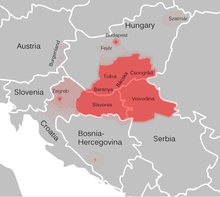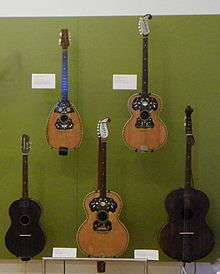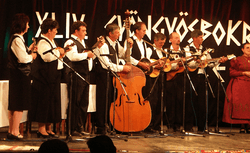Tamburica
 | |
| String instrument | |
|---|---|
| Classification | Plucked |
| Related instruments | |
Tamburica (/tæmˈbʊərɪtsə/ or /ˌtæmbəˈrɪtsə/) or Tamboura (Bosnian: Tamburica, Croatian: Tamburica, Serbian: Тамбурица, meaning "little Tamboura"; Hungarian: Tambura; Greek: Ταμπουράς, sometimes written tamburrizza or tamburitza) refers to a family of long-necked lutes popular in Southern Europe and Central Europe, especially Croatia, Bosnia and Herzegovina, Serbia (especially Vojvodina), Slovenia, and Hungary. It is also known in Burgenland. All took their name and some characteristics from the Persian tanbur but also resemble the mandolin and guitar in the sense that its strings are plucked and often paired. The frets may be moveable to allow the playing of various modes. The variety of tamburica shapes known today were developed in Croatia and Serbia by a number of indigenous contributors near the end of the 19th century.[1]
History

There is little reliable data showing how the tamboura entered Central Europe. It already existed during Byzantine Empire, and the Greeks and Slavs used to call "pandouras" (see pandoura) or "tambouras" the ancestor of modern bouzouki.[2] The instrument was referred to as θαμπούριν, thambourin in the Byzantine Empire (confer Digenis Akritas, Escorial version, vv. 826-827, ed. and transl. Elizabeth Jeffrey).
It is said it was probably brought by the Turks to Bosnia, from where the instrument spread further with migrations of Šokci and Bunjevci above the Sava River to all parts of Croatia, Serbia and further,[3] although this theory is not consistent with the generally accepted view that the ancestor of the tamboura is the ancient Greek pandouris.
Until the Great Migration of the Serbs at the end of the 17th century, the type of tamboura most frequently used in Croatia and Serbia had a long neck and two or three strings (sometimes doubled). Similar string instruments are the Czech bratsche, Turkish saz and the sargija, çiftelia and bouzouki. The oldest of the drum so far known, which is still kept in a museum in Osijek, dates from 1847 and was owned by Pajo Kolarić of Osijek, who is also the founder of the first amateur orchestra. According to him, today the festival called tamburitzan which is held every year in Osijek.[4]
The development process of the modern tamburica was initiated by several Croatian citizens over a period of time. The original long neck, pear shaped tamburica was called the samica and it came in a small or larger size. The kontra, 4 strings tuned in an upper A chord and used only as an accompaniment, originated in Dalmatia. In the fall of 1875. after a rebellion in Bosnia had broken out, many refugees arrived in Sremski Karlovci. Among these refugees was a man named Marko Capkun who brought two tamburas with him. He called the small one icitel and the larger one sarkija. These tambura did not use wire strings but rather gut strings pulled through little holes on the neck and tied behind. A woodworker, Josif, in Sremski Karlovci began to make Marko's tamburas but instead of the traditional pear shape, he made them into a shape of a tiny guitar. A bird catcher named Joza built a large tambura-much bigger than a guitar in 1877 or 1878. It stretched two thicker and two thinner strings on it and Joza called it the bas or berdon. They developed and orchestra with a little tambura called the prima , 5 kontra and 1 bas. [1]
Systems
Dual-fifths system bears the name by Milutin Farkas' Farkas system ". This system initially consisted of the first and second bisernom (the second name was still kontrašica), three brača, two of bugaria and berde . Later, they have an even čelović and čelo . This two-part note fifths system was widespread in Croatia, Bosnia and Herzegovina, Slovenia, Czechoslovakia and Western countries. In the second half of the nineteenth century in Backa and Srem there was a two-part note fourths system, but it quickly grew into a Triple. Three-note fourths system developed in Backa late nineteenth century. It consisted of a first and second tamburitza, third and fourth tambura, the first and second brothers and the bass. This composition of the drum, with the name changed instruments and additional forehead, was common in Srem. All are tamburitzas were pear-shaped, except for the bass, which had a shape similar to the double bass, and less frequently as the guitar. Triple-fifths system was first introduced Pera Z. Ilic 1897. These consisted of the first and second tamburitza, the first and second brothers, cello, bass and counter attacks. All tamburitzas were pear-shaped. This system is in Croatia first applied Alfons Gucci, and later by little perfected. In 1930 this system became the leading system in Croatia, in 1939 it was accepted by the Croatian tamburitza association, and since 1945, a member of the tambura orchestra of Radio Zagreb. The three-fifths tamburitzas are completely dry suction two-part (Farkas), who remained only in some Croatian regions. Four quart system developed from three quart, in the early twentieth century in Backa and Srem and hence his name "Srem" system . It consists of a first receiving (pearl) and tercprima (other pearl), basprim and basprim thirds (brac I and II), E-basprim (E-brothers), celovic, bugaria and bass (berde, begeš). In some orchestras there is also A-cons, as well as H-cons. In Slavonia is also accepted Srijemski system, but the instruments are tuned to tone down, to give the so-called '' d-tuning '' instead of '' e-wrong '' , which is leading in. There was a tendency to and Triple fifths system converts the four-fifths system, which is, with little success, argued Joseph Rorbaher from Osijek. The first conference tamburitza experts held in 1958 in Novi Sad, the conditions for the unity of all tamburitza system accepted the unique scores and hence unique names. In this unique musical score are represented: the first and second bisernica, first and second brac, E-brac, cello, bass and Bulgaria and čelović.[4]
Types of tamburica

The number of strings on a tamburica varies and it may have single or double-coursed strings or a mixture of both. Double-coursed strings are tuned in unison. The basic forms of tamburica are (Serbian and Croatian name is given with Hungarian name in the parenthesis, if different):
- The samica - while a solo instrument and not generally part of the tamburica orchestra,[5] two double strings.
- The prim (prím) - one double string, E, and three single strings B, F#, C#. This is the smallest tamburica (about 50 cm long), but is very loud. It is mostly used as a lead instrument or harmonizing instrument. The bisernica (from Serbian and Croatian "biser" meaning "pearl") is almost identical but may have two double strings and two single strings.
- The brač or basprim (brács or basszprím) - three double strings, or two double strings and three single strings (basprim), a slightly bigger, lower instrument than the bisernica but played in a similar fashion.
- The čelović - originally two double strings and two single strings; now four single strings are more common.
- The bugarija or kontra (brácsó or kontra) - one double string D and three single strings, similar to a guitar, mostly plays chords on the "back beat" for rhythm. A bugarija has five strings, the bottom pair are D, the middle string is A and the top two are tuned F# and F#.
- The čelo (cselló) - four strings, similar in size to the bugarija and plays a counterpoint line which is usually improvised.
- The bas or berda (tamburabőgő), also called begeš (bőgős) - four strings. It is the largest instrument in the tamburica family, and is similar to contrabass. It can only be played standing and is used for playing bass lines.
There is a view that the first tambura orchestra was formed in Hungary in the 19th century.[6] The instruments' names came from the Hungarian names of the musical instruments of the symphony orchestra ("cselló" meaning cello, "bőgő" meaning contrabass) and from the Hungarian Gipsy bands (bőgős, prím, kontra).[6][7] These orchestras soon spread to what is now Bosnia, Austria, Slovenia, the Czech Republic and Slovakia.
- Types of tamburica
.jpg) prim (bisernica)
prim (bisernica).jpg) bas-prim (brač)
bas-prim (brač).jpg) čelović
čelović.jpg) bugarija (kontra)
bugarija (kontra).jpg) čelo
čelo.jpg) bas (berda, begeš)
bas (berda, begeš)
Parts of tamburica
The tamburica is made in three parts; body, neck and head. The body (sound box) was pear-shaped until the middle of the nineteenth century CE, and was built by scooping out the log. Today they are mostly built in the way of the guitar and even the smallest, the bisernica, has a constructed box. The fingerboard has frets (Serbo-Croatian: prečnice, krsnice, pragovi). The head (Serbo-Croatian: čivijište, Hungarian: fej) usually had a sharpened form, which can be found still on some bisernicas, but the "snail" design later got the supremacy.[8] The snail headstock design dates from at least the 19th century and the Viennese guitars of Johann Georg Stauffer.
Composers and ensembles
Tamburica orchestras can have various formats from a trio to a large orchestra. A basic trio consists of a prim, a kontra and a čelo. Larger orchestras also have bas-prims and bass-prim-terc tamburas.
The first major composer for the tamburica was Pajo Kolarić, who formed the first amateur tamburica orchestra in Osijek in 1847.[9] Kolarić's student Mijo Majer formed the first tamburica choir led by a conductor, the "Hrvatska Lira", in 1882. Croatian composers for the tamburica include Franjo Ksaver Kuhač, Siniša Leopold and Julije Njikoš. The instrument is associated with Croatian nationalism. Vinko Žganec, an associate of Béla Bartók, collected more than 19,000 Croatian folk songs.

The Grand Tamburica Orchestra of Radio Novi Sad was founded in 1951 under the leadership of Sava Vukosavljev, who composed and arranged many pieces for tamburica orchestra and published a comprehensive book Vojvođanska tambura ("The Tambura of Vojvodina"). There are also orchestras of Radio Belgrade and Radio Podgorica, Radio Kikinda etc. Janika Balaž, a member of the Radio Novi Sad orchestra who also had his own octet, was a popular performer whose name became synonymous with the tamburica. Famous tamburica orchestras of Serbia include those of Maksa Popov and Aleksandar Aranicki.
The village of Schandorf in Austria, whose Croatian-speaking inhabitants are descended from 16th Century Croatian immigrants, is the home of a tamburica orchestra, a reflection of its ethnic heritage. The orchestra performs frequently, often outside the village.[10]
In popular culture
Films about tamburicas
- The Popovich Brothers of South Chicago (1978)[11]
- Directed by Jill Godmilow, Martin Koenig and Ethel Raim. Produced by Mary Koenig, Ethel Raim and Jill Godmilow.
- Ziveli! Medicine for the Heart (1987)[12]
- Filmed and directed by Les Blank. Produced by Flower Films in association with the Center for Visual Anthropology, University of Southern California. Based on ethnography by Andre Simic. El Cerrito, California: Flower Films & Video. ISBN 0-933621-38-8.
Publications
Svet Tambure, a magazine about tambura music, published triannually in Serbia.
See also
References
- 1 2 March, Richard (2013-11-14). The Tamburitza Tradition: From the Balkans to the American Midwest. University of Wisconsin Pres. ISBN 9780299296032.
- ↑ Elizabeth Jeffreys, John Haldon, Robin Cormack, The Oxford Handbook of Byzantine Studies, Oxford University Press, 2008, p. 928. Nikos Maliaras, Byzantina mousika organa, EPN 1023, ISBN 978-960-7554-44-4 [archive]
- ↑ Trešnjevka tamburica ensemble: Over tamburica - short history
- 1 2 "O tamburi". www.svita.net. Retrieved 2016-03-30.
- ↑ http://www.atlasofpluckedinstruments.com/europe2.htm#croatia
- 1 2 Volly István: Bajai tamburások - A bajai tamburazenekar története (1964.)
- ↑ Magyar Néprajzi Lexikon, Akadémiai Kiadó, Budapest 1977-1982
- ↑ Trešnjevka tamburica ensemble: Over the Tamburica – in general
- ↑ http://www.croatianhistory.net/etf/folk.html
- ↑ Schandorf Čemba: TAMBURIZZAORCHESTER (in German)
- ↑ Ebert, Roger (March 28, 1978). "THE POPOVICH BROTHERS OF SOUTH CHICAGO". http://www.rogerebert.com/. Retrieved 25 June 2014. External link in
|publisher=(help) - ↑ "Ziveli: Medicine for the Heart (1989)". The New York Times. Retrieved 25 June 2014.
External links
| Wikimedia Commons has media related to Tamburica. |
- TamburicaOrg - tamburaški portal - tambura portal
- Tamburizza.at - Tamburizza Verein Ivan Vukovic-Parndorf
- Tambura.com.hr (in Croatian)
- Tamburica Association of America
- About tamburica - short history
- The Tamburitza and the preservation of Croatian folk music, by Michael B. Savor (Canada)
- The San Francisco Tamburitza Festival
Music samples
- "Ugrós, lassú és friss csárdás", from Bátmonostor, Hungary
- "Aki leány akar lenni" (csárdás), from Bogyiszló, Hungary
- "Lassú csárdás", from Dávod, Hungary
- "Zvečera se šečem", Tamburica ensemble "Ivan Vuković", Parndorf, Austria
- Z. Tonković: "Sjene" (Croatia)
- Janika Balaž and his orchestra: "Fala" (Croatia/Zagorje)
- "Deronjski valcer", from Deronje, Serbia
